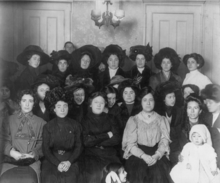New York shirtwaist strike of 1909
The New York shirtwaist strike of 1909, also known as the Uprising of the 20,000, was a labour strike primarily involving Jewish women working in New York shirtwaist factories. It was the largest strike by female American workers up to that date. Led by Clara Lemlich and the International Ladies' Garment Workers' Union, and supported by the National Women's Trade Union League of America (NWTUL), the strike began in November 1909.
In February 1910, the NWTUL settled with the factory owners, gaining improved wages, working conditions, and hours. The end of the strike was followed only a year later by the Triangle Shirtwaist Factory Fire, which exposed the plight of immigrant women working in dangerous and difficult conditions.[1]
History
Background
During the 20th century American textile workers of all categories—and female textile workers in particular—were subjected to abysmal working conditions, marked by crowded, unsanitary facilities, long work days, and miserable wages. Production in the garment-making capital of New York City during the first decade of the century was split between 600 shops and factories, employing 30,000 workers and producing an estimated $50 million worth of merchandise annually.[2]
Women were frequently trapped by an internal subcontracting system, which made extensive use of home work and additionally limited entry into skilled "operator" positions by relegating many to the ranks of "learners"—a category of convenience which had little correlation to actual level of skill or experience.[2] These so-called "learners" often earned no more than $3 or $4 a day—a small fraction of the typical wages of $7 to $12 made by semi-skilled "operators," who were generally male.[2] At the top of the garment industry hierarchy were the skilled pattern-makers and cutters, who were almost exclusively male.[2]
Garment industry workers often worked in small sweatshops.[3] Work weeks of 65 hours were normal, and in season they might expand to as many as 75 hours. Despite their meager wages, workers were often required to supply their own basic materials, including needles, thread, and sewing machines. Workers could be fined for being late for work or for damaging a garment they were working on. At some worksites, such as the Triangle Shirtwaist Company, steel doors were used to lock in workers so as to prevent workers from taking breaks, and as a result women had to ask permission from supervisors to use the restroom.[4]
The industry was dominated by immigrant workers, including prominently Yiddish-speaking Jews, about half of the total, and Italians, who comprised another one-third.[3] About 70% of the workforce was female, about half of whom were under 20 years old.[3]
In the production of shirtwaists (blouses) in particular, the workforce was nearly all Jewish women. Some of them had belonged to labour unions in Europe before their immigration; many of the Jewish women in particular had been members of the Bund. Thus, they were no strangers to organized labour or to its tactics. Indeed, Jewish women who worked in the garment industry were among the most vocal and active supporters of women's suffrage in New York.[4]
Strike

On November 22, 1909, Clara Lemlich had been listening to men speak about the disadvantages and cautions about the shirtwaist workers going on a general strike. After listening to these men speak for four or more hours at a local 25 union meeting, she rose and declared in Yiddish that she wanted to say a few words of her own. After rising to the podium, she declared that the shirtwaist workers would go on a general strike. Her declaration received a standing ovation and the audience went wild. Clara then took an oath swearing that if she became a traitor to the cause she now voted for, then that the hand she now held high wither from her arm.[5]
On the 24th of November, less than one day after the strike had been declared, 15,000 shirtwaist workers walked out of the factories, with more joining the strike the following day. The strike lasted until February 1910 and ended in a "Protocol of peace" which allowed the strikers to go back to work and met the demands of the workers, which included better pay, shorter hours, and equal treatment of workers who were in the union and workers who were not.[6]
Legacy
The successful strike marked an important benchmark for the American labour movement, and especially for garment industry unions.
See also
Footnotes
- "Sweatshop Tragedy Ignites Fight for Workplace Safety" on the American Postal Workers Union website
- Tony Michels, "Uprising of the 20,000 (1909)," in Paula E. Hyman and Deborah Dash Moore (eds.), Jewish Women in America: An Historical Encyclopedia. New York: Routledge, 1997; vol. 2, pp. 1432–34.
- Friedheim, William. "Heaven Will Protect the Working Girl: Viewer's Guide to the 30 Minute Documentary" (PDF). American Social History Project. Archived from the original (PDF) on 2010-06-15. Retrieved 2009-11-01.
- Sachar, Howard M. (1992). "The International Ladies Garment Worker's Union and the Great Revolt of 1909". Modern History. MyJewishLearning.com. Retrieved 2009-11-01.
- Dwyer, Jim (2011-03-23). "About New York; One Woman Who Changed The Rules". The New York Times. ISSN 0362-4331. Retrieved 2018-03-25.
- Greenwald, Richard A. (2005). The Triangle Fire, Protocols Of Peace: And Industrial Democracy In Progressive. Philadelphia: Temple University Press. ISBN 1592131751.
Further reading
- Haddix, Margaret Peterson (2011). Uprising. Simon and Schuster. ISBN 978-1442419568.
- Malkiel, Theresa Serber (1910). The Diary of a Shirtwaist Striker: A Story of the Shirtwaist Makers' Strike in New York. New York: The Co-operative Press.

